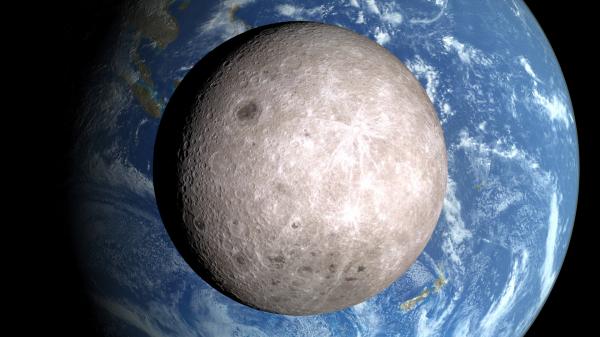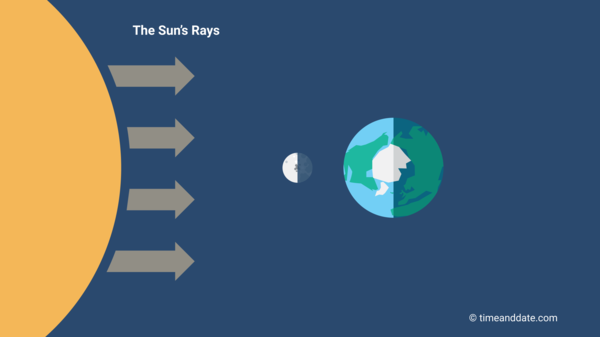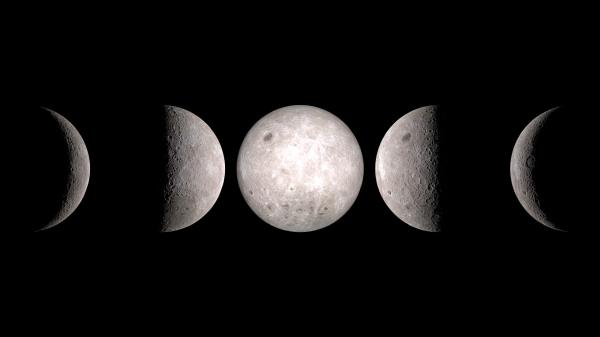No Dark Side of the Moon
Despite the popularity of the phrase “dark side of the Moon,” there is no such thing. There is, however, a far side.

We can never see the far side of the Moon from Earth, but thanks to satellites and spacecraft, we can see pictures of it.
©NASA/LRO
Jan 2025: See the planets at their best
From Earth, we always see the same side of the Moon. This side is known as the near side. We can never see the other side of the Moon—the far side—from Earth.
The Moon: Our natural satellite
Opposite Phases on the Far Side
Overall, half of the Moon’s surface is always illuminated by sunlight. As the Moon orbits Earth, it changes how much of the lit-up half we can see.
On the far side of the Moon, the Moon phases are exactly opposite to the ones we see from Earth. When we see the Moon fully illuminated at Full Moon, the far side is in darkness. When it is New Moon here, it’s Full Moon on the far side.
Is the Moon upside-down in the other hemisphere?


At New Moon, the side we see from Earth is in darkness, while the far side of the Moon is fully lit up by the Sun’s rays.
©timeanddate.com
Why Do We Never See the Far Side?
The reason the same side of the Moon always faces Earth is that the Moon rotates around its axis at the same speed as it revolves around Earth. This effect is known as tidal locking, and it is caused by the tidal forces of our planet.
In the same way as the Moon exerts tidal force on our planet, causing tides on Earth, our planet exerts tidal force on the Moon. Earth is larger than the Moon, so its tidal force is much more powerful. Over time, this force has slowed down the Moon’s rotation until it reached a speed matching the speed of its orbit around Earth.
All of the major moons in the solar system—including the Galilean moons of Jupiter, and Saturn’s Titan—are tidally locked to their parent planet.
Sleep, crime, and menstruation: how the Moon affects humans
Lunar Libration
However, there is a small variation to this rule. Since the Moon revolves around Earth on an elliptical path, the Moon’s distance from Earth varies from day to day. The point of the orbit closest to Earth is called perigee, while the point farthest away is known as apogee.
Like all celestial objects with elliptical orbits, the Moon’s speed varies a little on its path around Earth. It speeds up when it is closest and slows down when it is farthest away from us. At perigee, the Moon’s orbital speed is a little faster than its rotational speed.
This variation in speed, along with other factors, causes an effect called lunar libration. From Earth, the Moon seems to rock slightly from north to south and wobble a little from east to west. Over time, it is possible to see up to 59% of the Moon’s surface, but only 50% at a time. In other words, over time, we can see up to 9% of the outskirts of the Moon’s far side from Earth.

The far side of the Moon has the same Moon phases as the side we see from Earth, at the opposite time.
©NASA/LRO
A Mystery until 1959
Humans had no idea what the far side of the Moon looked like until October 1959, when a Soviet spacecraft, Luna 3, transmitted the first grainy images.
During the next five decades, the quality of lunar images has vastly improved, especially because of NASA’s Lunar Reconnaissance Orbiter (LRO). This spacecraft has been orbiting the Moon, collecting data since 2009. Today, we have detailed maps of the Moon’s topography, including the once mysterious far side.
On January 3, 2019, the Chinese rover Yutu-2 made the first soft landing on the Moon’s far side. One of its findings has been that soil on the lunar surface is stickier on the far side than on the near side.
Far Side Conspiracy Theories
A quick search on the web shows plenty of references to the “Dark Side of the Moon.”
It is the title of a widely popular album from 1973 by English rock band Pink Floyd. There are also films with the same name: an American 1990 science fiction thriller and fantasy action film “Transformers: Dark Side of the Moon” and German thriller “Die dunkle Seite des Mondes” involving a lawyer who becomes a wanted man after a psychedelic mushroom trip.
You will also find a vast amount of more or less humorous conspiracy theories about secret Moon bases and UFOs, along with images from the far side of the Moon showing what some claim to be structures created by humans or aliens.